When the Mary Tyler Moore Show debuted on CBS on September 19, 1970, I was 10, and at the height of my tuffy tomboy period. And while I liked the program’s heroine Ms. Richards well enough, at that age I wasn’t too interested in her career or her elegance or her fabulous wardrobe. I watched the show mainly for the laughs and the offbeat characters: Dimwitted Ted Baxter, curmudgeonly Mr. Grant, kooky Rhoda, and haughty Phyllis.
But as I came of age during the show’s long network run (through 1977), I grew to embrace Mary Richards as a role model. She had a cool apartment in an old Victorian house and an exciting job in the male-dominated news business (which was of great interest to me; I’d end up declaring a journalism major in college). For all her physical perfection, she evoked an air of vulnerability as she stammered her way through arguments with her grouchy boss over pay raises and equality. She never managed to throw one decent dinner party — something I’d relate to one day. She was so tidy and practical, organizing her closets when she felt like blowing her top. But what I loved best about Mary was that she never seemed to care that she didn’t have a boyfriend, a husband or kids. All too often, writers succumb to marrying off a character when they’ve run out of good storylines or are trying to attract a new audience. TV’s first single working woman, Ann Marie (Marlo Thomas) of That Girl, remained a free agent during most of the series’ five-season run, but ended up becoming engaged to goofy ol’ Donald Hollinger in 1971. No, the Mary Tyler Moore Show writers (one-third of whom were women, a rarity back then!) stuck to the feminist agenda. In fact, I suspect that the sitcom’s star, the talented MTM herself, wanted it that way.
I was a very late bloomer and never had a boyfriend in junior high or high school, except for a brief four-month period in 10th grade (and it’s important to note that he was a boy from a neighboring town, and was either unaware or unconcerned that I was considered D-List material at my own school. Read more.) So, the fact that a beautiful, intelligent, classy dame like Mary Richards never had a steady beau gave me hope. She had an interesting career. She had friends. She was liked. She was happy. All of THAT, without a man or kids. Wow. The theme song lyrics from the show’s first season said it all:
How will you make it on your own?
This world is awfully big,
Girl, this time you’re all alone.
But it’s time you started living.
It’s time you let someone else do some giving.
Love is all around, no need to waste it,
You can never tell, why don’t you take it.
You might just make it after all.
You might just make it after all.
Girls, you CAN make it. Don’t ever let society pressure you into thinking you need a guy to make your dreams come true. Parents, sit your young ladies down and introduce them to the life and times of MTM!
In loving memory of Mary Tyler Moore, December 29, 1936, to January 25, 2017.
© Dana Spiardi, January 26, 2017
]]>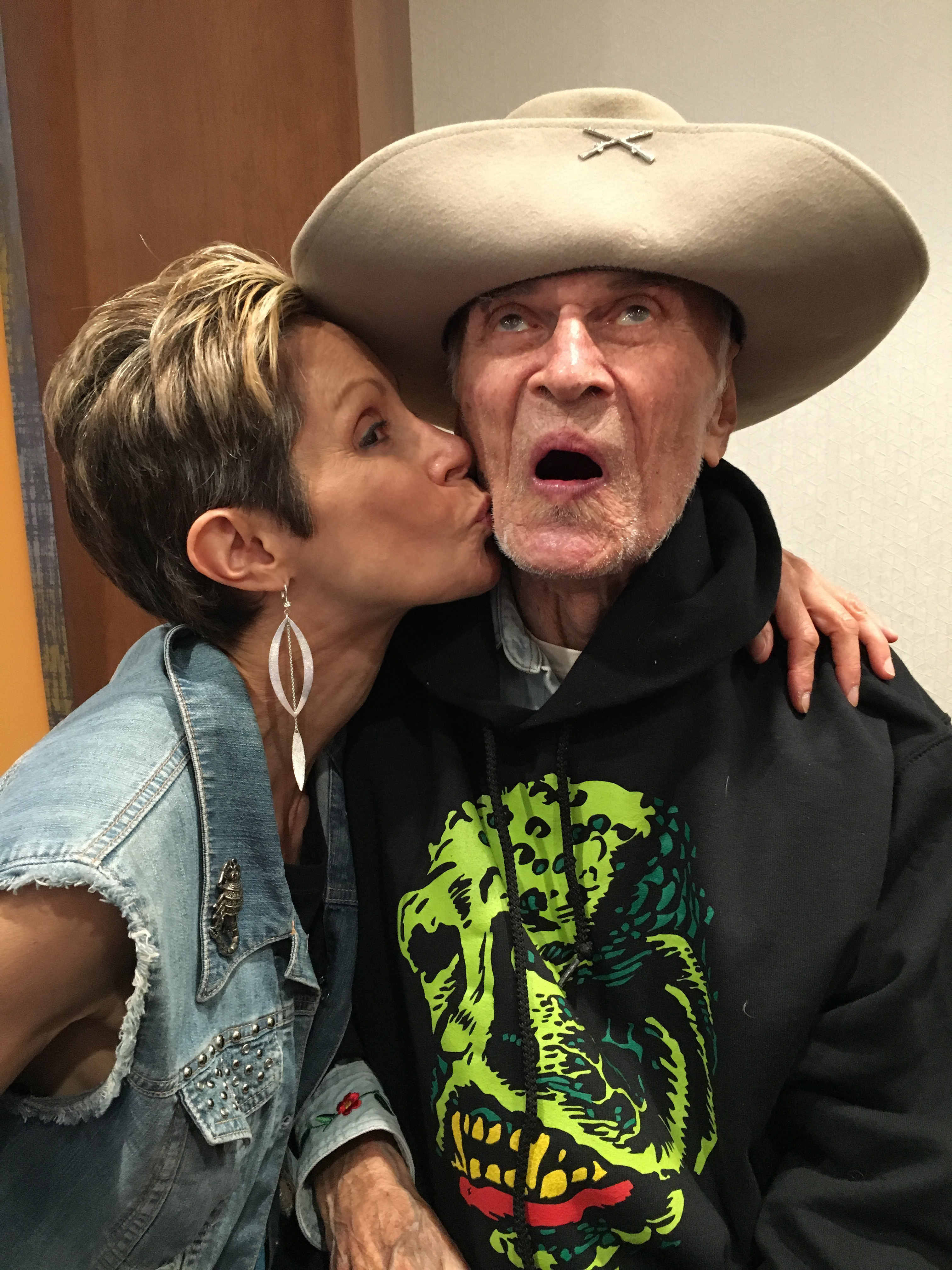 Well, this past weekend, I got that chance, when I not only met, but KISSED, Lawrence Samuel Storch during his appearance at a Monster Bash convention near Pittsburgh PA.There he was, at age 94, a bit frail, but tidy and quietly attentive, signing autographs and posing for pictures with adoring fans. First off, I told him I loved him, and thanked him for his eight decades of service to the entertainment industry. Then, I went straight for the gags, rephrasing the classic F-Troop line, “Now, why does everybody say I’m so dumb?” He smiled and began to sign the photo I purchased from his tabletop display. “Make sure you sign it ‘with love,’” I said. He answered, “Okay, but shall I sign it ‘Larry’ or ‘Larry Storch’?” I told him to include his last name, in the off chance some philistine would see the picture on my wall and ask about his identity.
Well, this past weekend, I got that chance, when I not only met, but KISSED, Lawrence Samuel Storch during his appearance at a Monster Bash convention near Pittsburgh PA.There he was, at age 94, a bit frail, but tidy and quietly attentive, signing autographs and posing for pictures with adoring fans. First off, I told him I loved him, and thanked him for his eight decades of service to the entertainment industry. Then, I went straight for the gags, rephrasing the classic F-Troop line, “Now, why does everybody say I’m so dumb?” He smiled and began to sign the photo I purchased from his tabletop display. “Make sure you sign it ‘with love,’” I said. He answered, “Okay, but shall I sign it ‘Larry’ or ‘Larry Storch’?” I told him to include his last name, in the off chance some philistine would see the picture on my wall and ask about his identity.
 Then, I regaled him with my story of how I used to sit with my girlfriends, Kathy B. and Mary M., in a small lunchroom at our workplace in the 1980s, sharing F-Troop gags and singing the theme song. (Mary’s husband Majeed once bemoaned, “She makes me watch that show every night on Nickelodeon!” Hey, what better way for an intellectual from Saudi Arabia to absorb American high-culture?) Well, Mary’s F-Troop dreamboat may have been klutzy Captain Wilton Parmenter (played with pratfall-panache by the talented Ken Berry), but Kathy and I were staunch Storchers from day one. And we weren’t the only ones! As I was waiting in line to meet Larry, I overheard a woman gushing to him about the huge crush she had on him as a kid.
Then, I regaled him with my story of how I used to sit with my girlfriends, Kathy B. and Mary M., in a small lunchroom at our workplace in the 1980s, sharing F-Troop gags and singing the theme song. (Mary’s husband Majeed once bemoaned, “She makes me watch that show every night on Nickelodeon!” Hey, what better way for an intellectual from Saudi Arabia to absorb American high-culture?) Well, Mary’s F-Troop dreamboat may have been klutzy Captain Wilton Parmenter (played with pratfall-panache by the talented Ken Berry), but Kathy and I were staunch Storchers from day one. And we weren’t the only ones! As I was waiting in line to meet Larry, I overheard a woman gushing to him about the huge crush she had on him as a kid.
 What can I say? Some of us just have highly-refined taste in men. We don’t dig the ones with the usual matinee idol looks (although, check out some early publicly stills of Larry; he was a hottie!) There was just something about that little guy. As Agarn, he was downright adorable in his yellow kerchief, red undershirt, suspenders, and oversized hat (he was the only one in the show who donned a white one; how nonconformist, I thought!) But his appeal had more to do with the lovable, relatable nature of his character: all bark and no bite, always late to grasp a joke or insult (“who says I’m dumb?”), a relentless hypochondriac, berating the cowardly troops of Fort Courage one minute and falling apart at the seams the next, burying his head in the chest of scheming Sergeant O’Rourke (the mighty Forrest Tucker) and tearfully wailing, “Oh, Sarge!” (For the record, I used to think Mr. Tucker looked a bit like my dad).
What can I say? Some of us just have highly-refined taste in men. We don’t dig the ones with the usual matinee idol looks (although, check out some early publicly stills of Larry; he was a hottie!) There was just something about that little guy. As Agarn, he was downright adorable in his yellow kerchief, red undershirt, suspenders, and oversized hat (he was the only one in the show who donned a white one; how nonconformist, I thought!) But his appeal had more to do with the lovable, relatable nature of his character: all bark and no bite, always late to grasp a joke or insult (“who says I’m dumb?”), a relentless hypochondriac, berating the cowardly troops of Fort Courage one minute and falling apart at the seams the next, burying his head in the chest of scheming Sergeant O’Rourke (the mighty Forrest Tucker) and tearfully wailing, “Oh, Sarge!” (For the record, I used to think Mr. Tucker looked a bit like my dad).
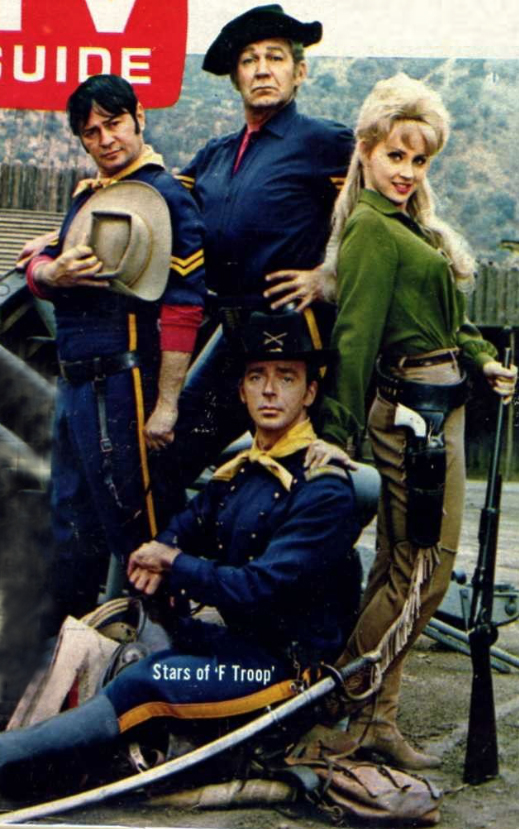 The tomboy in me longed to be Captain Parmenter’s sharpshooting, trading-post paramour Wrangler Jane (the late Melody Patterson, a 16-year-old cutie who lied about her age to get the part), strutting the wooden sidewalks with frontier fearlessness, in boots, fringed jacket, tight buckskin britches, and lasso gloves. But I figured I’d always be more akin to the hapless Agarn.
The tomboy in me longed to be Captain Parmenter’s sharpshooting, trading-post paramour Wrangler Jane (the late Melody Patterson, a 16-year-old cutie who lied about her age to get the part), strutting the wooden sidewalks with frontier fearlessness, in boots, fringed jacket, tight buckskin britches, and lasso gloves. But I figured I’d always be more akin to the hapless Agarn.
Eventually, I’d grow into a cynic, read “Catch 22,” and realize that stories about bumbling military misfits might be closer to real life than I’d like to imagine. As an adult I’d roll my eyes at the racist portrayal of F-Troop’s Hekawi Indian characters (who, nonetheless, were wiser than the soldier-dogs). But back when I was a child of six, the metaphors of a misfiring canon, a tone-deaf bugler, and a blind man in the watchtower were nothing more than gags.
Today, I wish I could view my misfit life, with all its misfirings, tone-deaf thoughts, and confusion along the watchtower, as a silly satire like F-Troop. Well, maybe it’s possible, if I can just march-step outside my cluttered Fort Fear of a mind and find some humor in my self-absorbed situations.
I see my encounter with Larry Storch as a type of wake-up call, as I trudge through a difficult phase of my life…my own personal war’s-end Reconstruction Period. He’s 94 years young, still spreading joy and inspiring playfulness. Today, I choose to embrace my inner-Agarn soul, with all its flaws, goofiness, and sweetness. I’m proud to be a humble little corporal, making the daily rounds through my own personal Fort Courage.
© Dana Spiardi, June 26, 2017
Okay, folks, let Agarn teach you to dance, in one easy lesson! Also featured in this clip are Hollywood legend Edward Everett Horton as medicine man Roaring Chicken, Italian-American character actor Frank de Kova as Chief Wild Eagle, and Forrest Tucker as Sarge.
And, because I know you’re just dying to sing along, here’s the F-Troop theme song from the show’s opening credits!
]]>
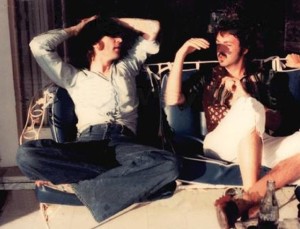 Well, as it turns out, they sat in the Lennons’ living room and watched Saturday Night Live! Imagine their surprise when SNL producer Lorne Michaels appeared on their TV screen, announcing an offer to pay the Beatles $3,000 to come together and perform three songs on his show! He held up a check and said, “NBC has authorized me to offer you a certified check for $3,000….you can divide it anyway you want. If you want to give Ringo less, that’s up to you.” What a commentary on the creative pecking order, albeit at poor Ringo’s expense!
Well, as it turns out, they sat in the Lennons’ living room and watched Saturday Night Live! Imagine their surprise when SNL producer Lorne Michaels appeared on their TV screen, announcing an offer to pay the Beatles $3,000 to come together and perform three songs on his show! He held up a check and said, “NBC has authorized me to offer you a certified check for $3,000….you can divide it anyway you want. If you want to give Ringo less, that’s up to you.” What a commentary on the creative pecking order, albeit at poor Ringo’s expense!
John later told David Sheff, author of the book All We Are Saying, “He [Paul] was visiting us at our place in the Dakota. We were watching it [SNL] and almost went down to the studio, just as a gag. We nearly got into a cab, but we were actually too tired.”
WHAT? Two healthy guys in their mid-thirties, too tired? From what…smoking too much weed? How dare they deprive the world of what would have been the biggest event in rock history! Oh, well. Yoko would have tagged along and ruined the whole thing anyway.
A month later, Michaels again tried to lure the Beatles, this time with a sum of $3,200 and an offer by NBC to pay for their hotel accommodations! He asked SNL announcer Don Pardo to provide more details. Here’s the hilarious transcript:
First of all, the lads from Liverpool will be picked up by a radio-dispatched Checker cab that will whisk them to the Cross Town Motor Inn, located in the heart of New York’s fashionable garment district. Once there, they will check in, in the recently renovated lobby; and then it’s off to their rooms via round-the-clock elevator service. They’ll be treated like royalty, as pitchers of ice water are hand-delivered to their rooms, and they can drink that water from glasses sanitized for their convenience. Oops — Ringo spilled a little something on his jacket? No problem — not with prompt forty-eight-hour dry cleaning service! ‘In by Tuesday, out by Thursday.’ And let’s just put a shine on those shoes, too, with a free shoe shine cloth. And, Lorne, since the Beatles will be staying in separate rooms, the four Mop Tops can speak to each other as much as they want because there is no charge for room-to-room calls. And, after a hard day’s night, the Beatles can sleep as late as they like with a leisurely checkout time of 10 A.M. That’s the Cross Town Motor Inn, a hotel tradition, hosting New York’s visitors since 1971. Yeah, yeah, yeah! Back to you Lorne!
Okay, pretty funny, but the huge sums offered by other industry moguls were nothing to scoff at. Three months before Lorne Michaels’ offer, promoter Bill Sargent tried to bait the Beatles with a payment of $50 million. And later in the year, Sid Bernstein, the man who promoted the Beatles’ early U.S. tours, offered a staggering $230 million for them to perform a one-time-only charity concert. The four turned it down, although sources say Paul considered it.
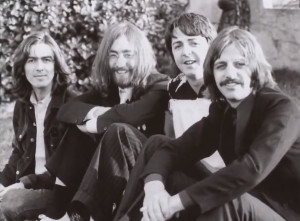 The closest thing to a Beatles reunion took place on May 19, 1979, when Paul, George, and Ringo jammed at the wedding of Eric Clapton and Pattie Boyd (George’s ex-wife). They performed shaky, alcohol-laced renditions of “Get Back,” “Sgt. Pepper’s Lonely Hearts Club Band,” and “Lawdy Miss Clawdy.” But where was John? He and Clapton had been tight in the early ’70s, when the guitarist performed with John at his Live Peace in Toronto concert. Did Eric and Pattie forget to send John an invitation? Did Yoko receive it and toss it in the trash? In Peter Doggett’s book, You Never Give Me Your Money, Clapton said, “John later phoned me to say that he would have been there too if he had known about it.” Sadly, all hopes for a Beatles reunion were abandoned on December 8, 1980, when John was assassinated as he entered his apartment.
The closest thing to a Beatles reunion took place on May 19, 1979, when Paul, George, and Ringo jammed at the wedding of Eric Clapton and Pattie Boyd (George’s ex-wife). They performed shaky, alcohol-laced renditions of “Get Back,” “Sgt. Pepper’s Lonely Hearts Club Band,” and “Lawdy Miss Clawdy.” But where was John? He and Clapton had been tight in the early ’70s, when the guitarist performed with John at his Live Peace in Toronto concert. Did Eric and Pattie forget to send John an invitation? Did Yoko receive it and toss it in the trash? In Peter Doggett’s book, You Never Give Me Your Money, Clapton said, “John later phoned me to say that he would have been there too if he had known about it.” Sadly, all hopes for a Beatles reunion were abandoned on December 8, 1980, when John was assassinated as he entered his apartment.
When the Beatles played their impromptu “concert” on the rooftop of the Apple Records building during the “Let It Be” recording sessions in January 1969, little did anyone know it would be the final live performance of the greatest and most influential band in history. It was the world’s finest free concert. Priceless.
Here’s Lorne Michaels, offering The Beatles the BIG check, on April 24, 1976:
© Dana Spiardi, April 24, 2013
]]>
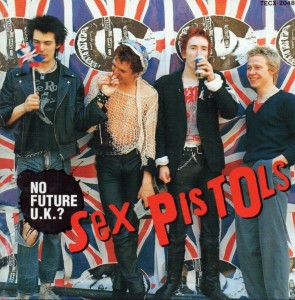 By the time the four Pistols – Johnny “Rotten” Lydon, Steve Jones, Paul Cook, and Glen Matlock – walked on stage they were cocked and loaded. They’d just released their first single, “Anarchy in the U.K.”, and were itching to carry out the song’s manifesto. Blasé host Bill Grundy antagonized them from the start: “They’re heroes!” he scoffed. “Not the nice clean Rolling Stones.” He then announced “They’re as drunk as I am,” and proceeded to provoke the lads by sneering at the £40,000 advance they’d just received from their record company, EMI.
By the time the four Pistols – Johnny “Rotten” Lydon, Steve Jones, Paul Cook, and Glen Matlock – walked on stage they were cocked and loaded. They’d just released their first single, “Anarchy in the U.K.”, and were itching to carry out the song’s manifesto. Blasé host Bill Grundy antagonized them from the start: “They’re heroes!” he scoffed. “Not the nice clean Rolling Stones.” He then announced “They’re as drunk as I am,” and proceeded to provoke the lads by sneering at the £40,000 advance they’d just received from their record company, EMI.
Guitarist Steve Jones hurled the first obscenity: “We’ve f**kin’ spent it, ain’t we?” Next came orange-haired Johnny Rotten, who said “shit” under his breath. When Grundy forced him to repeat it, he spit it out loud and clear.
Grundy then turned his attention to the ladies on stage, there as fans and no doubt thrilled to be included in this historic media moment. When punk pioneer Siouxsie Sioux of the Banshees coyly told Grundy she’d always wanted to meet him, the schnockered host suggested they “meet afterwards.” This elicited the following exchange:
Jones: You dirty sod. You dirty old man.
Grundy: Well keep going, chief, keep going. Go on. You’ve got another five seconds. Say something outrageous.
Jones: You dirty bastard.
Grundy: Go on, again.
Jones: You dirty f**ker.
Grundy: What a clever boy.
Jones: What a f**king rotter.
Was Grundy goading the insolent boys as a ploy to boost ratings? Or was he really that drunk…or stupid?
Whatever the case, British viewers were outraged. Angry callers jammed the station’s phone lines for hours, while the press savored every minute. The Daily Mirror introduced the story with this now-famous headline: “The Filth and the Fury!” The phrase was so fitting that director Julien Temple used it 20 years later as the title of his Sex Pistols documentary.
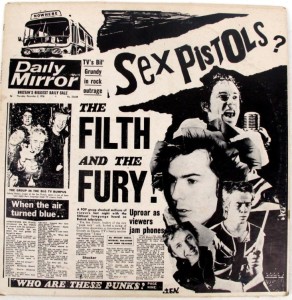 The 3-minute interview from hell ended Grundy’s career and catapulted the band to international notoriety overnight. They went on to release just one album during their three-year run – “Never Mind the Bollocks, Here’s the Sex Pistols” – now considered a groundbreaking assault on the bloated world of 1970s arena rock, as well as a pointed attack on Britain’s ruling class. Iggy Pop, The New York Dolls, and The Ramones may have laid the groundwork for what would become known as punk rock, but it was the Pistols – and, in particular, Sid Vicious, who joined in 1977 – that set the standard for punk attitude and style with their safety-pinned t-shirts, jackboots, dog collars, bondage trousers, and asylum haircuts. They spit on the audience, and the audience spit back. And the band loved very minute of it. Proudly unpolished as musicians, they nonetheless influenced countless acts, from The Clash to Nirvana.
The 3-minute interview from hell ended Grundy’s career and catapulted the band to international notoriety overnight. They went on to release just one album during their three-year run – “Never Mind the Bollocks, Here’s the Sex Pistols” – now considered a groundbreaking assault on the bloated world of 1970s arena rock, as well as a pointed attack on Britain’s ruling class. Iggy Pop, The New York Dolls, and The Ramones may have laid the groundwork for what would become known as punk rock, but it was the Pistols – and, in particular, Sid Vicious, who joined in 1977 – that set the standard for punk attitude and style with their safety-pinned t-shirts, jackboots, dog collars, bondage trousers, and asylum haircuts. They spit on the audience, and the audience spit back. And the band loved very minute of it. Proudly unpolished as musicians, they nonetheless influenced countless acts, from The Clash to Nirvana.
Looking back on the most controversial live TV event in U.K. history, Malcolm McLaren told The Guardian in 2007, “As simple and harmless as it seems today, that interview was a pivotal moment that changed everything. Punk became the most important cultural phenomenon of the late 20th century. Its authenticity stands out against the karaoke ersatz culture of today, where everything and everyone is for sale. Punk’s influence on music, movies, art, design and fashion is no longer in doubt. It is used as the measurement for what is cool. And we all know you cannot sell anything today if it is not cool. The only problem is that punk is not, and never was, for sale.”
No, punk ideology is not for sale, but punk fashion is, and yer blogger’s not ashamed to admit that through the years she’s spent a pauper’s fortune on spiked bracelets, padlock pendants, zipper-embellished clothing, hair-spiking gels, skull rings, and black boots galore. Viva la punk!
Here’s the famous interview. In the front row, from left, are: Johnny Rotten (John Lydon), Steve Jones, Glen Matlock, Paul Cook, and Grundy. Standing in the back are members of the Bromley Contingent, a group of Pistols fans. Siouxsie Sioux is at the far right, sporting platinum hair.
Here are the Pistols debuting “Anarchy in the U.K.” on British TV:
Dana Spiardi, Dec 1, 2012
(The photo of the Pistols with straws is by Bob Gruen).
]]>
As a boob-tube loving adolescent, I was equal parts baffled and delighted by a 1969 PSA featuring a montage of clean, healthy people, cut to a suave Broadway-type tune sung in the style of Julie Andrews. Here we have a gurgling baby and a graceful ballerina, a coy debutante and a clean-cut daddy – all laughing and romping to this refrain:
VD is for everybody, not just for the few
Anyone can share VD, with someone nice as you.
Well, I didn’t know what VD was, but if it made people this carefree, I wanted someone to share it with me! I desired this VD stuff in the same way I craved what those women in the magazine tampon ads possessed: freedom, confidence, and comfort!
Ah, but all too soon I would learn all about this mysterious VD. And I would come to live in total fear of it. VD, after all, was for everybody! Was I doomed to get a venereal disease? As an ugly duckling tween surely destined to be a spinster, I ruled out all possibility of sexual intercourse as a means of transmission. But what about toilet seats? Like the 9-year-old boys in “South Park” who wore condoms all day for fear of contracting AIDS, would I need some type of protection? Maybe those tampon things would guard me! But Mommy said only married ladies wore those. Hmmm. This would trouble me for months on end. Until I learned about…DRUGS!
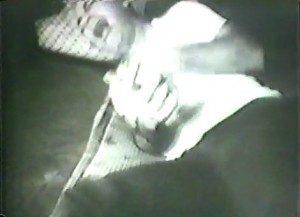 A body dumped in a trash heap. A man shooting up at a sink. A boy convulsing in a jail cell. These were all scenes from a grainy, graphic 1972 PSA warning against the evils of illicit drugs. This haunting black-and-white reality piece featured a catchy song delivered in the hand-clap style of a jump-rope rhyme. Although both black and white actors appear in the scenes, the song is unmistakably performed by a chorus of African Americans of all ages, stretching the boundaries of modern-day political correctness. And the “Ten Little Indians” theme of the song – nine little Indians feelin’ great, one OD’d, then there were eight – would today be considered derogatory to Native Americans. But despite all that, the video remains the most powerful anti-drug PSA I’ve ever seen. And, as a fan of realistic filmmaking and clever lyrics and rhymes, I consider it a fine example of provocative video art.
A body dumped in a trash heap. A man shooting up at a sink. A boy convulsing in a jail cell. These were all scenes from a grainy, graphic 1972 PSA warning against the evils of illicit drugs. This haunting black-and-white reality piece featured a catchy song delivered in the hand-clap style of a jump-rope rhyme. Although both black and white actors appear in the scenes, the song is unmistakably performed by a chorus of African Americans of all ages, stretching the boundaries of modern-day political correctness. And the “Ten Little Indians” theme of the song – nine little Indians feelin’ great, one OD’d, then there were eight – would today be considered derogatory to Native Americans. But despite all that, the video remains the most powerful anti-drug PSA I’ve ever seen. And, as a fan of realistic filmmaking and clever lyrics and rhymes, I consider it a fine example of provocative video art.
Okay, so you managed to avoid VD and steer clear of drugs. But what if poor grades prevented you from entering college? You watched PBS documentaries galore, read Camus and Kafka, but you just didn’t have the SAT scores. Well, there was a PSA for that, too — one featuring a dejected Abe Lincoln leaving an unemployment office after being told he wasn’t executive material because he lacked a college diploma. “You ain’t goin’ nowhere without that sheepskin, fella,” says a seedy-looking job rep, as he stuffs a sandwich into his mouth and wipes the mayo from his face. In 1860 a smart guy like Lincoln could become president without that sheepskin, but it would take a lot more to get ahead by 1970. That’s why the College Level Examination Program (CLEP) was established. It allowed people to gain college credits for what they’d learned on their own.
Those creative PSAs from the early 70s left an indelible impression on me: protect your private parts, say no to drugs, and avoid a life of drudgery by getting into college. I wonder if today’s young people are as daunted by public service announcements as I was 40 years ago. When was the last time you saw a PSA worth remembering?
By Dana Spiardi, Aug 12, 2013
]]>